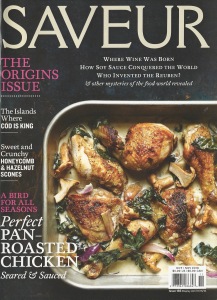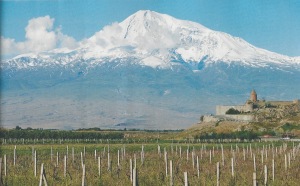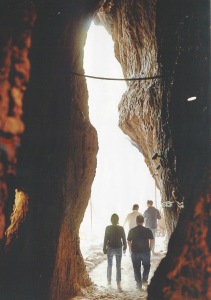Simanaitis Says
On cars, old, new and future; science & technology; vintage airplanes, computer flight simulation of them; Sherlockiana; our English language; travel; and other stuff
THE ORIGIN OF WINE
SAVEUR IS MY FAVORITE culinary magazine. It’s more than a collection of recipes, some straightforward and others exotically complex. Saveur is also a travel magazine, exploring how people around the world live as well as what they enjoy eating and drinking.

Saveur, The Origins Issue, October/November 2016, Issue 189.
I’ve already devoured The Origins articles, focusing on the chicken and the egg, Norwegian cod, root vegetables, soy sauce, vanilla and wine. Not all in one recipe, mind.
The image of Mount Ararat caught my eye. I know of it from Noah’s ark fame, but didn’t know that this peak was at 16,854 feet, in the eastern tip of Turkey and on the Armenian Plateau.
Sixty miles to the east of Mount Ararat in neighboring Armenia is the Areni-1 complex, a cave uncovered in 2007 containing one of the world’s oldest winemaking operations. Author Adam Leith Gollner and photographer William Hereford visited this ancient winery for Saveur. Here are tidbits (or maybe more properly, sips) from their tale, “Where Does Wine Come From?”
The National Geographic Society and UCLA are exploring the Areni-1 site, a significant one in mankind’s evolution from nomadic subsistence to agricultural society. The cave was inhabited during the early Copper Age, some 6000 years ago, a transition between the Stone Age and Bronze Age.
Gollner cites pomologist (fruit scientist) Edward Bunyard’s charming description: “We can picture the Father of our civilization, genial and complacent amid the stir of camp-breaking, answering those who urged him to his packing, ‘No! I stay here until this grape juice is finished. It gets more tasty every day.’ ”
The grape, it turns out, is special in the simplicity of its transforming juice into alcohol. Notes Gollner, “As soon as grapes release their juices, the yeasts living on the skins break down the sugars, producing alcohol and carbon dioxide. A pile of grapes, left to their own devices, will start to ferment automatically.”
Areni-1 is perfectly suited for this: temperature controlled, today with gray-white earthenware jugs, thousands of years old, sunk into the cave’s sandy floor.
There are four varieties of Armenian grapes today. Gollner describes them: The Areni are best known, producing “fresh, bright red wines with soft, elegant red fruit flavors.” The Kakhet are “violet-purple in color, with small berries that make for sweet, fresh, floral juice.” The Sireni, originally from the South Caucasus, is a “thick-skinned red grape with tannic structure.” Last, the Tchilar was nearly extinct until recently and is considered the one to watch in the coming years. It “falls somewhere between a sauvignon blanc and a grüner veltliner.”
Unlike most Saveur stories, “Where Does Wine Come From?” contains only a single recipe, for Armenian stuffed cabbage. I’d serve it with an Areni red, “somewhere between a mondeuse from Savoie, a Chianti riserva and a volcanic red from Etna.”
Sounds great to me. ds
© Dennis Simanaitis, SimanaitisSays.com, 2016





I recall a brief discussion with an aunt who was Seventh Day Adventist and my mother, a devout Lutheran (and an RN). I had just returned from six months in Israel and mentioned visiting the area where Jesus was said to have turned water into wine. My aunt tried to correct me and said it was grape juice. My mother, bless her, rejected that saying in that era with no refrigeration etc. you had two possibilities — wine or vinegar. Besides, what kind of miracle was turning water into grape juice? We can also note that Hebrew, Ancient Greek and Aramaic all have specific words for wine and juice and in the original texts, the word was wine. L’chaim!
this arrived in my mail box at the same time your wine post came in
t a wine merchant’s, the regular taster died and the director started looking for a new one to hire.
A drunkard with a ragged, dirty look came in to apply for the position.
The director of the winery wondered how to send him away.
He gave him a glass to drink.
The drunk tried it and said: “It’s a Muscat, three years old, grown on a north slope, matured in steel containers. Low grade, but acceptable!”
“That’s correct”, said the boss.
Another glass….”Cabernet, eight years old, a south-western slope, oak barrels, matured at eight degrees. Requires three more years for finest results.”
“Correct.” And the next …”It’s a pinot blanc champagne, high grade and exclusive,” calmly said the drunk.
The director was astonished.
He winked at his secretary, secretly suggesting something.
She left the room, and came back in with a glass of urine.
The alcoholic tried it. “It’s a blonde, twenty six years old, three months pregnant – and if I don’t get the job, I’ll name the father.”
Thanks, Grey. I needed that.